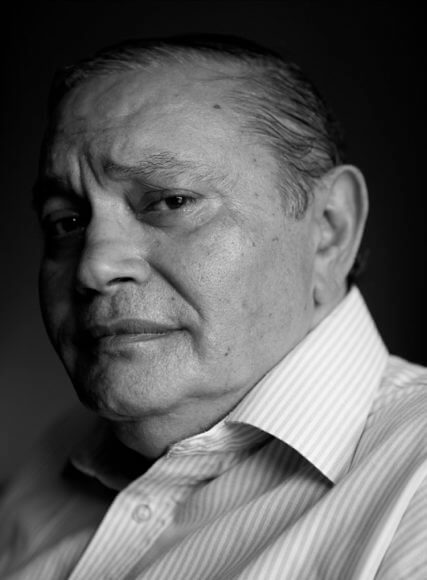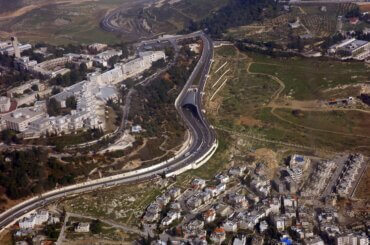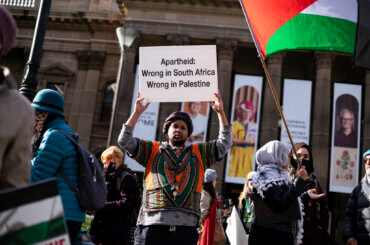Kochavi Shemesh, one of the founders and an ideologue of the Black Panthers movement in Israel died on April 13, 2019 at 75. Born in Iraq in 1944 in a Jewish hospital in memory of Rabbi Meir Baal Haness, he immigrated to Israel with his family in 1950 where he then grew up in the Iraqi and Moroccan neighborhood of Musrara in Jerusalem. At the time of his youth many Jews from Middle Eastern and Arab countries identified as Sephardic, Arab-Jews who trace origins in Spain and Portugal and were exiled in the late 1400s. But the Black Panthers and Shemesh cultivated a separate revolutionary identity of Mizrahi (literally, “eastern”); Jews from the Middle East and North Africa who balked at the Zionist hegemony that sought to create a separation between Jews and Arabs. They fought against political, social and ethnic discrimination within Israeli society on Mizrahi Jews, and later many of the founding members of the Black Panthers protested alliance with Palestinians.
I personally met Shemesh in 2011 at an event where a street was named after the Black Panthers and hung in Musrara, just outside of Jerusalem’s Old City. We had been in touch ever since. In him, I discovered a modest, funny man with a big heart.
Today, as seen in the last elections, discourses of social justice and equity in Israel have disappeared. We should remember that in Israel, there is no party dedicated to the underclass. There are no representatives for poor people and Palestinians who live under occupation in the West Bank and Gaza. Of course the Joint List in Israel represents Palestinian citizens of Israel, but this excludes the occupied Palestinian territory where around 4.7 million Palestinians live under one of or a combination of colonization, an military regime, and a blockade.
The Black Panthers stood apart with a particular voice to a unique historical experience and at the same time had a universal and inclusive social vision. When Shemesh and his activist friends at the Black Panthers movement went to battle, the Mizrahim did not exist as a political movement. The Ashkenazim, or Jews with origins in Europe, spoke on their behalf. This did not prevent the Panthers from writing sharp manifestos, leading demonstrations and joining the Palestinian struggle.
When Shemesh was only 22, he stole milk bottles and brought them to needy families in Jerusalem. He was only 22 years old when he stood in Jerusalem’s Zion Square with other young people and read a poignant social manifesto, which to this day is revolutionary in its demands.
The Black Panthers movement was innovative in many areas. It was founded in 1971 as a protest movement. In the first few years of existence the group held several marches challenging racial discrimination against Mizrahi Jews. At its peak, 15,000 participated in the demonstrations.
It adopted its name – and other key motifs – from the Black Panther Party in the U.S., thus creating an ideological connection between black Americans and their struggle in the U.S. against racial discrimination, and pan-African movements in general and the Mizrahi-Palestinian struggle in Israel. Leaders of the Israeli Panthers went on to join the heads of Matzpen, a radical Marxist movement founded in Israel in the 1960s.
The actions of the Black Panthers were numerous: They faced an establishment that had sent them the Shin Bet, the police and lawyers, and buried them in court orders, but they understood the depth of the oppression and the method and bravely faced it. They brought a black coffin to a demonstration against the regime that did not count them in.
One only has to understand that Israel in the 1960s and 1970s was still ruled by the melting pot ideology, meaning everyone should be unified by Zionist symbols. Underpinning this was a social force that everybody should accept the white European narrative of David Ben-Gurion and his Mapai party, a predecessor to today’s Labor Party and the governing party from Israel’s founding to 1977. With that in mind, to see young Moroccan, Iraqi and Mizrahi unemployed youth choosing both a black coffin and a Black Panther as symbols to protest against the establishment was a revolutionary move. They changed the Magen David, or star of David into a dead man’s coffin; they changed the white Europe idea into a dark symbolism of Africa; they took ideas from the 1960s and 1970s movements in the third world and pan-African movements to create a graphic resistance which came from a new consciousness; they connected the Mizrahi struggle with the African American struggle and the third world anti-colonial struggle.

The leaders of the Black Panthers were among the first Israelis to meet with the PLO and its late chairman Yasser Arafat, which was particularly shocking to the the Ashkenazi dominated government at the time as they tried to prevent ethnic, class and social connections between Mizrahi and Palestinian organizers.
From the moment Israel was founded the Zionist establishment spoke in behalf of the Mizrahi. They were politically ignored. So in the government they had only a few jobs, like head of the post office or the police and so. Until today there actually there was never a Mizrahi prime minister (remember Mizrahim are half of the Jewish society in Israel).
Another example, education curriculums were written by Ashkenazi Jews who decided Mizrahi Jews needed to learn about the European culture because it was regarded as better for them to lose their Arab, therefore inferior, culture. The Jewish Moroccan culture was regarded as inferior. The Mizrahim were seen as primitive people coming from primitive societies and needing to be brought again into culture by a social system of social workers, educators and prisons and so on. The radical idea of a Mizrahi human being as equal to Ashkenazi person was talked about only when the Black Panthers came to the power. You can read about it here in an article by Sami Shalom Chetrit.
The Ashkenazim spoke on their behalf and narrowed our culture into a racist caricature.
It was Europeans, American and Ashkenazi doctors who conducted illegal and unethical radiation treatments on Mizrahi children in the ringworm affair in the 1950s; it was Ashkenazi doctors who Mizrahi mothers alleged abducted their children during the early years of statehood; it was the Ashkenazi establishment who made Mizrahi immigrants into a proletariat by settling them in the periphery and limited jobs to menial labor, suppressing their culture; and then – it was Ashkenazi actors who costumed themselves as stereotypes of Mizrahi characters and wrote books about Mizrahi figures and describe their identity narrowly. Amidst this prevention of work, welfare and social justice, young people like Kochavi Shemesh, Charlie Biton, Reuven Abergil, Saadia Marciano and others founded the Israeli Black Panthers. They wrote social and political manifests, they organized demonstrations and they opposed the whole regime.
As a movement, the Black Panthers are sometimes described as an apparent failure because they did not become a mass movement. But their demonstrations Before the Yom Kippur war in 1973, made a difference. The Rabin government, which came to power after the 1973 war, tripled social budgets. According to professor Danny Gutwein, a prominent historian of the Israeli left at Haifa University, the most egalitarian period in the history of Israel according to the Gini coefficient, a wealth inequality assessment, was between 1974 and 1977. The Zionist state was shocked by the demonstrations of the Panthers from within and by the attack of the Arab states from the outside and decided to correct course.
When members of the Panthers moved into politics in the decades that followed, Kochavi objected to Charlie Biton’s running in the communist party on the Rakah list, a forbearer to Maki, the Israeli Communist Party and today’s Hadash political faction. Biton unsuccessfully campaigned for a seat in the Eighth Knesset and again tried with Eddie Malka, another Black Panthers member, in the 1980s. He then joined the Mizrahi Front, a Mizrahi organization initiated by the known activist Vicky Shiran, an Israeli criminologist, sociologist, poet, film director and media personality. She was a leader of a movement promoting Mizrahi Jewish consciousness in Israel. She was an advocate of equal rights and played a key role in the fight for the advancement of Mizrahim (Jews who originate from Arab or Muslim countries). She was among the founders of the Mizrahi Democratic Coalition and the feminist group Achoti, and is considered one of the founding mothers of the Mizrahi feminist movement.
Vicky Shiran later went on to join the Tami Party and was one of the founders of the Mizrahi Democratic Rainbow in the 1990s. The Mizrahi Democratic Rainbow was the first movement to create an alternative Mizrahi-Israeli narrative that included the 1972 uprising of the Black Panthers movement. The Mizrahi Democratic Rainbow was founded with a mass of intellectuals and creative activists from the second generation (born in the 1950s and 1960s in Israel or Arab states). They brought the idea that Mizrahi isn’t an origin but a consciousness to change the whole power structure of Israeli society and its political scheme. They went to higher court to demand social justice and wrote books and created a new Mizrahi voice. This movement viewed the Black Panthers as their ideological partners. They wrote PhD dissertations and books explaining the context of the Black Panthers revolutionary ideas.
Shemesh never stopped learning and teaching. In the 1980s he co-founded the Mizrahi Front. In 1983 he opened a bar in Tel Aviv, aptly named “The Red Bar” where Tel Avivian bohemian figures frequented, including the likes of writers Dan Ben Amoz and Amos Kenan. In 1992 with his friend and activist from the Black Panthers, Saadia Marcian, he founded a rehab clinic. The treatment center is located in pastoral Kfar Zoharim in central Israel. He named the place after the famous Mizrahi singer Zohar Argov who died in 1987 in prison from an accidental suicide after years of struggling with a heroin addiction. This center was successful and continues to help people to date, almost 30 years after it first opened its doors.
In 1999 he began studying law and in 2003 he passed the Israeli Bar. He then worked as a lawyer and he continued to lecture on social justice. Shemesh was one of the sharpest opponents of the fascist “Kahane Chai” movement that was banned from the Israeli Knesset in 1994. He spoke out against the group’s founder Rabbi Meir Kahane who built his base by entering Mizrahi peripheral neighborhoods, exploiting the class and ethnic conflict in an attempt to turn the Mizrahim into Arab haters.
Shemesh has participated in various films about the Black Panthers, including “Black Panthers Talking” by the Mizrahi public intellectual Sami Shalom Chetrit and “Did you hear about the Black Panthers” by Israeli documentary filmmaker Nissim Mossek.
The tremendous contribution of the Israeli Black Panthers, and Kochavi Shemesh in particular, to Israeli society, has not been taught in schools, nor has it been acknowledged by the public. When Mizrahi issues and struggles are taught, it is removed from its revolutionary context as a remote landmark in the country’s social history. Nevertheless the Panthers had a respectable ethos that promoted true social-democratic values and an egalitarian and just vision for society in Israel-Palestine.
“There is no peace without equality and there is no equality without peace,” Kohavi Shemesh always said, pointing out precisely the paradox of life in a Zionist state. There is a kind of anxiety in a society that does not reach to reach peace with Arab neighbor states, because in order to do that, Israel must face its internal problems. To solve the internal problems, the the concentration of power and resources (most of which are in the hands of a few Ashkenazi elite families in Israel) must be broken up and given to Mizrahi and Palestinian citizens, and to conceptualize Middle Eastern culture in general. Arab and Jewish are not identities in opposition.



Jews from the Middle East and North Africa who balked at the Zionist hegemony that sought to create a separation between Jews and Arabs. Yes, they are Arabs and are Jews. One does not negate the other. Yet the Euro Zionist Colonial movement does not recognize that. And the Jews of Arabia have suffered terribly at the hands of the European Zionist enterprise.
It is a human tragedy.
Great posting.